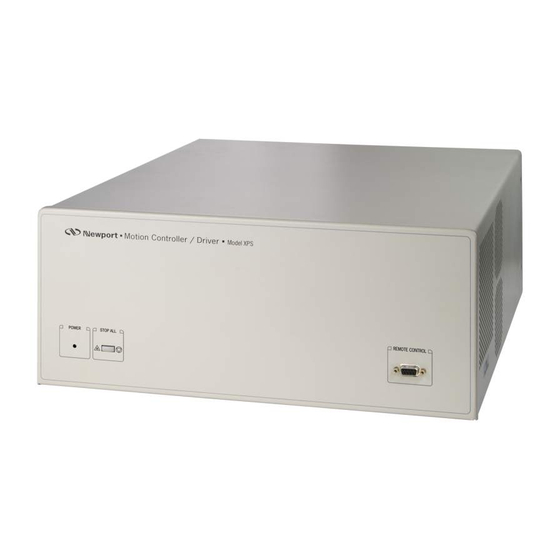
Advertisement
Quick Links
TECHNICAL NOTE
Trigger Synchronization using a
Newport XPS Series Motion Controller
In electro-optical experiments or automated test and measurement systems,
configuration of multiple instruments is often required to perform a series of
synchronized tasks. A common challenge of integrating multiple instruments
into a setup is the difficulty of controlling each of the instruments at a
precise timing, either simultaneously or in a specific sequence. When a
setup requires high accuracy and throughput motions, an ability to
synchronize tasks of the motion controller with other instruments becomes of
a key importance. This technical note describes trigger synchronization
methods of multiple instruments using a Newport XPS universal motion
controller and provides examples of specific configurations.
Overview:
Figure 1: Setup Configuration for Optical Quality Testing with Gimbal
Input and output trigger controls are common features for test, measurement
and motion control instruments including Newport XPS, ESP301 and SMC series
controllers as well as Newport optical power meters, laser diode drivers and
tunable laser controllers. In a schematic of typical setup shown in Figure 1, an
input trigger signals an XPS controller to start a specific task, and the controller
sends out an output trigger to other instruments at a programmed event.
Below is a list of key questions to consider when determining overall hardware
and software configurations for trigger synchronizations.
• What types of signals (digital or analog) are available to use as trigger in
and trigger out?
• What are the program logics that need to be defined for the trigger events
and actions?
• For digital TTL trigger, do the input/output pins require pull-up resistors or
are they pulled up internally?
• What is the acceptable time delay between events and actions when
synchronizing multiple instruments?
Digital and Analog Trigger
The XPS controller provides number of digital TTL inputs and outputs from
GPIO (General Purpose Inputs and Outputs) as well as from Trigger In, used as
External Trigger Input for Data Gathering, and PCO (Position Compare Output)
connectors. TTL is the most widely used form of trigger signal in various
instrumentations. TTL logic gate circuits are designed to input and output only
two distinct states of signals – "high" (1) and "low" (0). Ideally, the two states
are represented by voltage values, 5 volts for "high" and 0 volt for "low" in
positive logic. However, due to the stray voltage drop, the input and output
voltages are not exact values of 5 or 0 volts, and manufacturers specify
acceptable ranges for voltage and current values. The input and output
specifications of the TTL digital signal for the Newport XPS series controllers
are shown in Figure 2 and Figure 3 below.
Figure 2: XPS Digital TTL Input
Figure 3: XPS Digital Output
The digital TTL input and output of the XPS controller are in negative logic,
producing maximum 5 volts for "low" (0) state and minimum 0 volt for "high"
(1) state. As shown in Figure 2, the digital TTL input is internally powered by 5
volts supply. Hence, when connecting an output of an external device to the
digital TTL input of the XPS controller, no external pull-up resistor is required.
The digital TTL output, however, is an open-collector type as shown in Figure 3,
and it requires an external +5V power supply and a pull-up resistor. The GPIO1,
GPIO3, GPIO4 and PCO connectors of the XPS controller provide outputs of +5V
supply, that can be used to pull up the output signals.
The XPS also allows defining the trigger actions based on the analog input
signal values. In the GPIO connectors, there are 4 analog inputs and 4 analog
outputs that use voltage signals in range of ± 10 V.
Programming of GPIO Trigger Logics
A total of 30 TTL inputs and 30 TTL outputs are available in GPIO connectors of
the XPS controller. This allows synchronization of specific task executions
Advertisement

Subscribe to Our Youtube Channel
Summary of Contents for Newport XPS Series
- Page 1 The input and output into a setup is the difficulty of controlling each of the instruments at a specifications of the TTL digital signal for the Newport XPS series controllers precise timing, either simultaneously or in a specific sequence. When a are shown in Figure 2 and Figure 3 below.
- Page 2 Example #1: Digital TTL Output to Trigger a Mechanical Shutter the action is triggered. Some of the available events and actions are shown in In the following example, a Newport 845HP digital shutter system is triggered Figure 4. by digital TTL outputs from the GPIO3 connector of an XPS-Q4 universal controller.
- Page 3 PositionerPositionComparePulseParametersGet(GROUP1.POSITIONER, double *, double *) GroupMoveAbsolute(GROUP1.POSITIONER, 150) PositionerPositionCompareDisable(GROUP1.POSITIONER) For additional information about the Newport XPS controller and its advanced features for trigger synchronizations, please contact Newport sales and application engineers at tech@newport.com. www.newport.com Newport Corporation, Global Headquarters 1791 Deere Avenue, Irvine, CA 92606, USA...














Need help?
Do you have a question about the XPS Series and is the answer not in the manual?
Questions and answers